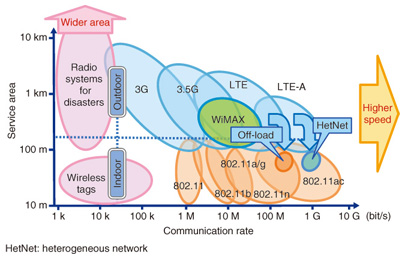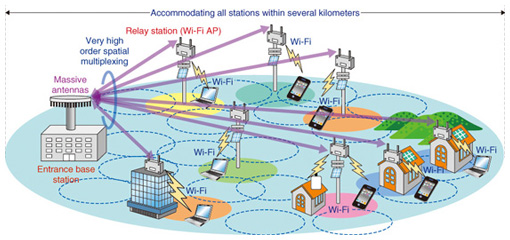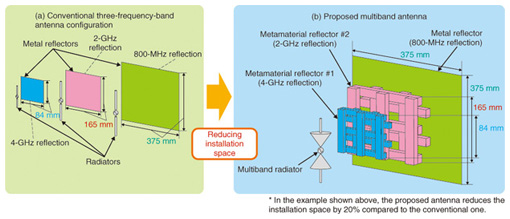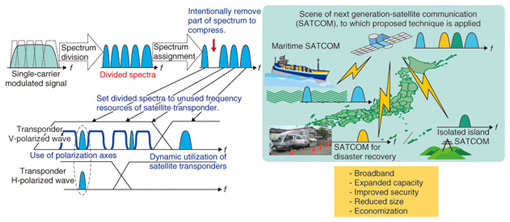 |
|||||||||||||||||||||||||||||||||
|
|
|||||||||||||||||||||||||||||||||
|
Feature Articles: NTT Tsukuba Forum 2013 Workshop Lectures Vol. 12, No. 3, pp. 48–53, Mar. 2014. https://doi.org/10.53829/ntr201403fa8 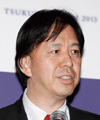 R&D Efforts on Wireless Access Systems Toward Realization of Future NetworksAbstractTo actively support social and service environmental changes, NTT aims to comprehensively strengthen the competitiveness of network services. NTT has been investigating future networks that will provide users with the best user experience. This article introduces the research and development activities underway on wireless access systems. These efforts are being carried out with the goal of realizing future networks, and they include techniques to improve frequency utilization efficiency, reduce power consumption, and advance antennas/propagation, satellite communication systems, and wireless systems for disaster recovery. Keywords: wireless access systems, frequency utilization efficiency, future networks 1. IntroductionThe recent popularity of smartphones and tablet terminals indicates that mobile services—whose traffic nearly doubles year by year—are replacing fixed services as the major player in telecommunications. Although telecommunications carriers must expand the network capacity to support the increasing traffic, they are not able to earn revenue proportional to the traffic increase since most services are provided at fixed rates; in other words, the revenue does not increase with the traffic. NTT is working to address this situation and has set the immediate goal of comprehensively strengthening its networks’ competitiveness as one of its medium-term business strategies known as Towards the Next Stage. By replacing conventional networks with service-oriented future networks, NTT aims to provide various users with the best user experience as required by each user. This requires providing access methods to suit the user’s environment, that is, the optimum combination of fixed and mobile services. It is important to provide multi-grade services to users in order to satisfy users’ performance and cost demands. NTT Access Network Service Systems Laboratories is pursuing the research and development (R&D) of fundamental and system technologies as part of efforts to realize future networks. 2. Direction of fundamental technologies for wireless access systemsConventional R&D activities designed to enhance usability of wireless access systems—including mobile and nomadic services—are intended to achieve two goals: expanded service areas and increased communication speeds. To respond to the increase in mobile and nomadic service traffic, more sophisticated systems have been standardized, and associated technologies have been developed. For example, the data rate for wireless local area networks (WLANs) that conform to the IEEE 802.11 standard was initially 1 Mbit/s and now exceeds 1 Gbit/s in IEEE 802.11ac. With regard to mobile service, 3G (third-generation) cellular is migrating to Long Term Evolution (LTE) and eventually to LTE-Advanced (Fig. 1).
The optimum scenario is to distribute sufficient frequency resources to each user to improve the quality of experience (QoE); however, the frequency resources available are limited. Traffic offloading from the mobile service to WLAN may be a good approach to address the traffic congestion issue, but there is a concern that even the WLAN frequency resources will be insufficient. The key to resolving this issue is to increase the overall system communication capacity as a space by enhancing the frequency utilization efficiency (spectral efficiency). 3. Technologies to improve frequency utilization efficiencyNTT is researching fundamental technologies, starting with short-term solutions such as improving intra-system frequency utilization efficiency, to mid/long-term solutions such as improving inter-system frequency utilization efficiency. We are adopting three approaches in this research: (1) Access point (AP) coordinated transmission techniques Demands for WLAN frequency resources utilized to offload user traffic from mobile services have been increasing due to the increase in the number of WLAN APs and mobile terminals equipped with WLAN capability. In the 2.4-GHz band, which originally had insufficient frequency resources, user throughput is degraded because of frame collision and radio wave mutual interference, which reduces user satisfaction. Although the 5-GHz band still has sufficient frequency resources, these resources are expected to be depleted in the near future. Two technologies to maximize areal throughput are being researched to improve user QoE against the backdrop of an explosion in the number of WLAN APs/stations. i) High efficiency WLAN technology that can autonomously harmonize APs and terminals [1]–[6]. ii) Wireless resource control technology to cooperatively control APs through a server on the network [6], [7]. (2) Massive-MIMO technology Massive-MIMO (multiple-input multiple-output) technology has been investigated to enable spatial sharing between systems and thus improve frequency utilization efficiency. The wireless entrance system may be the first example of applying Massive MIMO to wireless base stations. Terminals [8] can be simplified by using a sophisticated wireless entrance base station equipped with an antenna with approximately 100 elements; it can deliver radio waves with high directivity by beamforming and simple signal processing. It can also suppress interference power to other stations, which allows simultaneous transmission to large numbers of receivers. This significantly enhances frequency utilization efficiency (Fig. 2).
(3) Inter-system interference compensation technology Each system is generally assigned its own spectrum for its own use. To cope with the expected traffic increase, it is extremely important to improve frequency utilization efficiency by sharing frequency resources among different systems. With conventional methods, the system senses its environment before transmission and avoids collision with other systems through time or frequency adjustment. In all of these methods, however, a frequency resource is used by only one system, so frequency utilization efficiency is insufficient. Three interference compensation techniques are being investigated that enable the frequency to be shared by accepting a certain level of interference power and then using signal processing to offset the effect of the interference. These techniques are as follows (Fig. 3).
(i) Interference suppression (spectrum suppressed transmission) [9] (ii) Interference cancellation (wireless network coding) [10] (iii) Interference reduction (adaptive cooperative transmission) [11] Our target is to raise frequency utilization efficiency by a factor of 10 from current levels by 2015. 4. Power consumption reduction technologySome studies have examined ways to reduce power consumption and/or carbon dioxide emissions by using effective intermittent operation of wireless systems when no data are being transmitted. Although a standard for power-saving operation exists for current WLAN terminals, no such standard exists for APs. We have been doing research on WLAN sleep techniques for APs. These techniques are expected to be significantly improved by taking the following considerations into account. - Performance degradation is minimized by controlling the sleep time and/or frequency according to the traffic [12]. - No extra functions need to be added to terminals, and power-saving performance is improved through mutual-cooperation between multiple APs in addition to single-AP control [13]. - Systems operating without commercial electric power should be included within the scope of the investigation by combining environmental power generation and/or reduced-power devices. 5. Antenna and propagation technologyAntennas are portals for signals in wireless systems and so are extremely important devices. Improving their performance continues to be a major research topic. We have been investigating multiband base-station antennas whose reflectors are composed of metamaterials [14]. Metamaterials have a periodic arrangement of dielectric materials. The occupied volume can be reduced by replacing several single-band antennas, each designed for a specific frequency, with a single multiband antenna. Three-frequency-band antennas have already been developed, and we are continuously working on increasing the number of frequencies that can be shared (Fig. 4).
Clarifying the propagation characteristics is at the core of our research activities and is essential for designing the link budget of wireless systems. Transmission speeds of wireless systems have increased with the advances in technology, and because of this, views are changing on what propagation characteristics need to be clarified. Path loss characteristics were the main area of focus for the 1st or 2nd generation cellular systems in the ’90s. More recently, analysis of delay spread has become the focus of research for WLAN or 3G cellular systems. This spread is exemplified as the difference in signal arrival times due to reflections and diffraction of radio waves. Currently developed systems that use MIMO technology, for example, next-generation WLAN, achieve high speed and reliability by transmitting/receiving signals via multiple antennas, which enables the use of multipath signals. This requires analysis and modeling of spatial propagation characteristics in addition to conventional receiving level and delay-spread characteristics [15]. The frequency bands of interest are expanding from the UHF (ultrahigh frequency) and SHF (super high frequency) bands often used by wireless communication systems, to both lower and higher frequency bands. We are currently working on constructing propagation models in these bands and will contribute to the standardization efforts underway by ITU-R (International Telecommunication Union, Radiocommunication Sector) and will also consult on propagation issues for the wireless businesses of NTT Group companies. 6. Satellite communication systems using multi-domain signal processing technologyThe repeated assignment and release of different bandwidth signals within the frequency band of a satellite transponder fragments the frequency resource. Unused frequency resources that are not wide enough to be reallocated to new users cannot be used for communication; hence, the frequency utilization efficiency degrades. Multi-domain signal processing technology [16] is being applied to address this issue. In order to make effective use of the fragmented (and thus unused) frequency resources, a single-carrier modulated signal is split into subspectra that can be assigned to the unused frequency resources. In some cases, some parts of the subspectra may be intentionally deleted or concatenated to reduce the total frequency resource requirement. Moreover, the utilization of vertical and horizontal polarization axes enables the subspectra to be assigned over multiple domains such as frequency and space. Multi-domain signal processing technology makes it possible to effectively utilize unused frequency resources or to compress and transmit signals; with the limited transponder bandwidth, this yields wireless systems that can cope with more traffic than the conventional alternative. We have completed lab experiments and will conduct experiments using a real satellite transponder in 2014 (Fig. 5).
7. Wireless systems for emergency responseThe experience gained in the aftermath of the Great East Japan Earthquake has strengthened the importance of wireless systems in dealing with emergencies. However, some of the systems currently in use were introduced a long time ago, and their specifications should therefore be reviewed. In light of this, it is necessary to digitize all of our relay, subscriber, and business wireless systems, and also to reduce their size and weight, increase their capacity and service area, and introduce simplified settings and operation procedures. We are currently working on realizing such systems. 8. ConclusionConstructing the future access platform is crucial in order to provide users with the access method that best suits their environments and needs. Such methods will consist of finding the optimum combination of fixed and wireless access systems that will respond to various requests and fully satisfy user demands. We are continuing our research and development efforts to improve users’ satisfaction with the communication services provided. References
ProfileCareer highlightsExecutive Manager, Wireless Access Systems Project, NTT Access Network Service Systems Laboratories. Masashi Nakatsugawa received the B.E. degree in electronics and communication engineering and the M.E. degree in electrical engineering from Waseda University, Tokyo, in 1987 and 1989, respectively, and the M.S. degree in electrical engineering from California Institute of Technology, USA, in 1999. He joined NTT Radio Communication Systems Laboratories in 1989. His research experience includes the areas of MMIC circuit design, packaging technology, software defined radio, and wide-area wireless access systems. From 2010 to 2012, he was a Senior Manager in the Radio Division, Technical Planning Department, where he was involved in regulatory and standardization activities for wireless systems. He is currently responsible for the development of fundamental technologies for wireless access systems. He received the 1996 Young Engineer Award from the Institute of Electronics, Information and Communication Engineers (IEICE), and the Yokohama Research Park (YRP) Award from the YRP R&D Promotion Committee in 2002. He is a member of IEEE, IEICE, and the Japan Society of Applied Physics. |
|||||||||||||||||||||||||||||||||

